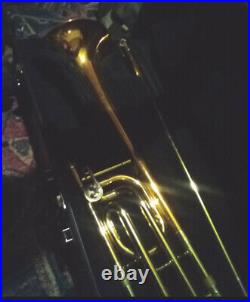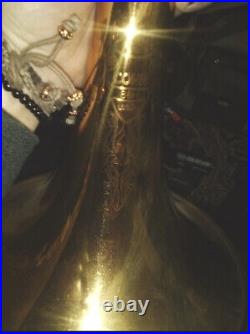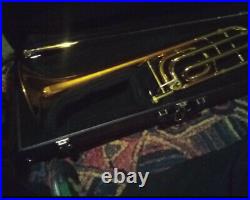



Conn Trombone 88H F-attachment Trombone with Lacquer Finish and Rose Brass Bell. Condition is “professionally used”, very well cared for. Introduced in 1954, the Conn 88H trombone has now been made in the USA for over 60 years. First built in Elkhart, IN, production later moved to Abilene, TX in the 1970’s, then Eastlake, Ohio in the 1980’s. The Conn components are still made in Ohio, but since 2016 the assembly and finish is performed in Elkhart, IN once again. Upon each occasion of a production move, the company forgot that they make historical instruments, thus quality and reputation suffered for some time. We are never past that. It’s Conn after all. But we’re at Elkhart era 2.1 and the new Conn trombones are excellent, with caveats. The assembly is clean and straight, buffing and lacquer are excellent, and the hand slides are very good though they need a little polishing or cleaning to remove stubborn grit, but it’s no worse than Bach Stradivarius hand slides. It’s not an Eastlake slide, but we’ll go with it and tune as necessary. We do inspect and adjust each trombone individually before sale because we think you should be impressed the first time you open the case. No after a short wait we receive sets of tuned-up Bach and Conn slides from our technician and they are spectacular. The Conn 88H is the archetype of the great orchestral tenor trombone of the late 20th century. This is the trombone that every other maker would like to offer, and they try. The 88H is as much at home in the symphony orchestra or concert band as it is in the recital hall, and that’s where it really excels. This trombone has similar dimensions to other popular large bore trombones. 547″ , 8.5″ bell. The Bach 42, also made by Conn-Selmer, has the same numbers. But the Conn is different. The hand slide is slightly narrower than those used on most Bach, Getzen, Shires, and other similar trombones. This adds a center and clarity of tone that others may not have. The bronze outside slide tubes are a slightly softer metal, adding warmth and breadth to the tone. The bell is a medium taper and is a bit smaller in the bell throat than the larger feeling Bach 42. These traits make the 88H an especially good solo instrument, and a perfect horn for the trombonist in the conservatory environment. Though we all like to play blastissimo in a large ensemble, much of our classical training is lessons, chamber music, solos and recitals. That’s where the clarity of tone and malleability of a slightly lighter medium dimension instrument like the 88H really soars. 1954 marked the official debut of the famous and now nearly ubiquitous model 88H. Prior to its release, a few 8H specials (custom large tenors with F-attachments made prior to 1954) were fabricated for influential and prominent orchestral trombonists. As more people heard a Conn 88H, the demand became immense. Beginning in the conservatories and professional symphony orchestra trombone sections, a great push encouraged a large tenor trombone with F-attachment to become the tool of the trade. Because of its control of the dynamic range and flexibility in the low register (with the addition of the F valve), the 88H caught on immediately with professional trombonists around the world. Vincent Bach, Conn’s competition at the time, released the model 42B shortly afterward in order to compete with the immense popularity of the 88H. Over the years, the 88H has remained the classic orchestral trombone sound. Many trombonists of the modern day grew up listening to recordings of their favorite trombone sections… Most of whom were playing 88Hs. Conn moved factory production from Elkhart, Indiana in 1972 to Abilene, Texas. While the horns made in Abilene were still quite good, most trombonists agree that the 88H’s best era was from Elkhart production. Trombone trends evolve and new valves, wraps, leadpipes and other features started to improve the instrument’s playability in the early 1980s. Conn later redesigned their famous model and renamed it the Generation II Conn 88H. Modern upgrades were now available such as: bell weight in two thicknesses (a standard and a thin walled model), open wraps, highly efficient rotary valves, removable leadpipes, new bell materials (yellow brass and sterling silver), and new manufacturing techniques to improve response and playability. Don’t worry, you can still acquire a classic closed wrap 88h (the model 88HT is the closest new trombone you can get to a classic Elkhart 88H). Regardless of which model 88H you pick, it is certain that it will function to the highest standards in any professional situation. We offer two bells on the Conn 88H. The standard bell of the 88H and 88HO is a bit thicker than those of many years ago, but it adds stability and projection. The tone holds together very well for even the loudest playing. Kyle Covington of the San Diego Symphony and others favor this bell. The lighter bell is designated by a “T” in the model number (T for Thin) and is used on the 88HT and 88HTO. This bell responds a bit faster and and has more clarity at lower volumes. The tone color may feel more malleable, so you can change the tone from dark to bright with less effort. The nuance player will appreciate this bell. It’s not overly thin, in fact it’s heavier than a standard Kanstul bell, so projection and tone are still very good. Conn now offers a yellow brass bell on the 88HY and 88HYO models. The yellow brass, having a lower copper content than the standard red brass bells, is a bit harder and should offer more projection. The tone color should be more stable from very soft to very loud volumes. Some of the malleability and warmth of the red brass bells is missing, so it’s a rare player who asks for this. These can be built to order in a few weeks. A Sterling silver trombone bell is something to behold. This bell is found on the 88HS and 88HSO trombone. This is the same type of bell you would find on the classic King Silversonic trombones. You’ll get more sound and clarity for your efforts, as well as a very quick response. These are available in lacquer finish, all silver plate, or silver plate with gold plated trim. Please call for a quote. Due to the lighter bracing on the Lindberg CL models, we find some of the Sterling bells may ring a bit. We’re not recommending those options be combined. The traditional wrap F-attachment of the 88H and 88HT is designed for the close confines of an orchestra pit or choir loft. The F crook does not notable stick out behind the main tuning slide. It’s also well braced and we find that these models always seem to play well and are well received, even by players who were considering a horn with a more modern look. The long F slide allows a pull to E, which is considered antiquated now, but can be useful for doubling on bass trombone parts. The open wrap F-attachment of the 88HO and 88HTO removes some of the tight bends so the air wave can flow through with less resistance. Response may be improved over the traditional wrap.. If so, it’s very subtle. The player will need to treat this model more gently, as the F-attachment loop is lightly braced and it sticks out a fair amount behind the horn, making gigs in close confines slightly risky. This wrap also allows a pull form F to E as necessary, something not available on the Bach 42BO or Yamaha Xeno models. Since the introduction of the Generation II Conns, the rotary valve used has been a design borrowed from the King 4B trombone. This rotor has slightly more curved and open knuckles to allow a smoother air flow and open blow. Renown trombone soloist Christian Lindberg endorses the Conn 88H, and his model, known as the 88HCL, has a larger rotor that is quite unusual. There are some ergonomic issues for players with wider jaws, it has a very open feel with a broader tone, and it’s a bit more airy than the standard models. Some players who blow a larger volume of air and use a deep cup mouthpiece like these, but it’s just a few. The standard hand slide included with the Conn 88H is made of bronze tubes with nickel trim and end crook. 547 bore with a standard leadpipe. The mouthpiece receiver is designed to accept any large shank mouthpiece with a Morse taper, which includes Bach and most others. Even Schilke mouthpieces now have the standard Morse taper shank. The Conn trombones can be ordered with several other hand slides. The standard slide is available with 3 removable leadpipes: The standard pipe, an open pipe favored by John Marcellus, and a traditional Remington style pipe that fits the now rare mouthpiece with the Brown & Sharp taper shank. Such mouthpieces include vintage Schilke, Conn, and Remington. The item “Conn Trombone 88H F-attachment Trombone with Lacquer Finish and Rose Brass Bell” is in sale since Sunday, December 27, 2020. This item is in the category “Musical Instruments & Gear\Brass\Trombones”. The seller is “tomboba86″ and is located in Overland Park, Kansas. This item can be shipped to United States.
- Brand: Conn
- Color: Pink
- Finish: Lacquered
- Custom Bundle: No
- Finish Material: Gold Brass
- Model: 88 HO
- Modified Item: No
- Bell Material: Rose Brass
- Type: Bass
- Skill Level: Professional
- MPN: 88H
